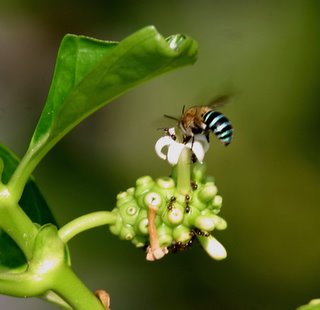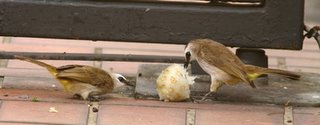I have a pair of slender-stemmed mengkudu (Morinda cirtifolia) growing by my gate along the driveway. The plant grows wild throughout Southeast Asia, having been introduced from Queensland, Australia a very long time ago. Now the Malay name is not as well known, replaced by the up-market name of noni. This is because some enterprising person decided that the fruits have all sorts of health-giving properties. And started marketing the juice as a health product.
The pair of 3-metres tall trees must have been brought there in the form of seeds by a bird. They are continuously flowering and fruiting profusely. The flowers are regularly visited by a variety of insects for their nectar. Flies and bees are always around. A few butterflies like the Palm Bob (Suastus gremius gremius) and Lemon Emigrant (Catopsilia pomona alcmeone) are regular visitors.
Daily one or more male Crimson Sunbirds (Aethopyga siparaja) visit the flowers for the nectar. I am sure there is also a female around but the male is so much prominent and attractive with his crimson colouration. They announce their presence by their high pitch chit, chit, chew sound they make. These smallish birds do not stay lon’ at one spot for a proper photographic shot but move rapidly from flower to flower all the time. And before you know it they have departed for another plant elsewhere.
Sunbirds also visit just after rain. They come and have a series of quick baths using the droplets that collect on the surface of the large leaves, see Bathing Sunbirds.
The ripe fruits litter the ground below. I have been told that in Hawaii, dogs love these fruits, growing fat on them. I am sure our local dogs eat them also, if given the opportunity. So far, I have seen two species of birds relish these rancid smelling fruits. Pairs of Javan Mynas (Acridotheres javanicus) will approach the ripe fruit lying on the ground, take a quick peck and retreat before coming again for another beak-full. Yellow-vented Bulbuls (Pycnonotus goiavier) similarly eat the fruits, but only when the mynas are not around.
On 24th December 2005 I was surprised to see a pair of these bulbuls making a ritual of eating the fruit. The pair was dancing around the fruit lying on the ground, tails flapping up and down and at regular intervals taking pecks from the fruit. It is interesting to note that these ripe fruits are never totally eaten, three quarters would always be left behind.
It would be interesting to receive feedback on what other birds go for these fruits.
Text and images by YC. Steven Chong assisted in identifying the butterflies.











2 Responses
I have learnt that nature always leave something behind. They are not greedy. Unlike humans, they will “harvest” everything and leave nothing behind. So, that was the reason why the bulbuls will not finish the noni.
I have seen a Lineated Barbet swallowing the whole fruit! The fruit was at least 1 inch in diameter. I think that barbet don’t have to ‘cari makan’ for the rest of the day after feeding on one. BTW, there were still alot of fruits on that tree – just proved the theory that nature always leave something behind.
Thanks for sharing your part of the story.
Forest Ang
Butterworth, Penang.